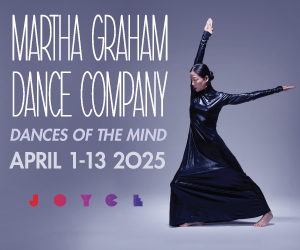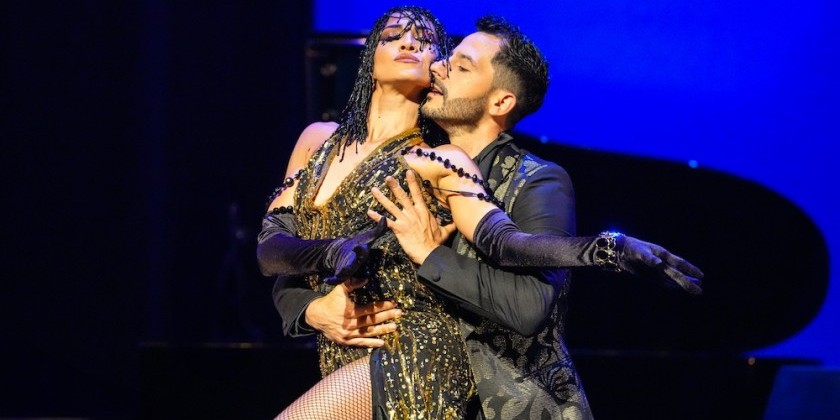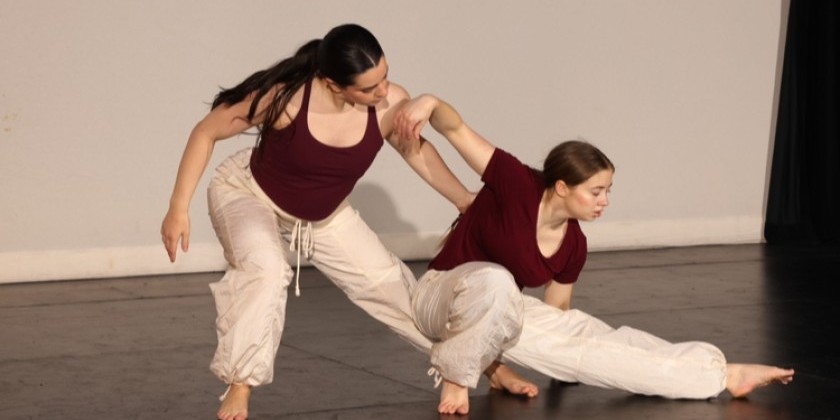AUDIENCE REVIEW: Queering the Divine: An Evening with Body Artifacts

Company:
Body Artifacts
Performance Date:
February 15, 2025
Freeform Review:
What does it mean to commune with the Divine? Body Artifacts founder, Chloe Sonnet Brown, and her collaborators supplied many possible answers to this question in their recent performance “Angel Visits.” Taking place in the Cathedral of St. John the Divine, this evening of dance certainly evoked the images of angels. Its Gothic architecture provided a powerful stage and immersive thrust seating dropping the audience into the thick of the performances. Carefully curated around the theme of visits from angels, this performance was very expressive, thought provoking, and poignant in today’s political climate, and most importantly, it was deeply queer.
Many budding queer youth and young adults who grow up immersed in religion, especially Christianity, go through an internal reckoning about whether they have a place in the church or even in the world. So many young people question their self worth and validity as they come to know more about their identities, and often feel pushed out of spiritual and religious spaces. This evening, on the other hand, created a space for queer and trans choreographers and dancers to make dance about their experiences communing with angels and to share it with others without fear of judgement or exile. It created a healing space to reclaim elements of one’s spiritual experience if they so choose, and it created a possibility for new spiritual experiences ushered in through the power of dance.
Opening the evening was Chloe Sonnet Brown’s “Joan,” a heartfelt retelling of the story of St. Joan of Arc. A striking duet between Chloe Sonnet Brown who took on the role of Joan of Arc, and collaborator Alicia Steeves who took on the role of God leading Joan throughout her call to action and supporting her through her trial and ultimate death. This duet was intimate and full of trust, shown through tender touches and care-filled gestures, as well as weightshare and partnering. What truly struck me was Steeves’ embodiment of God. Traditionally known as “God, the Father,” the leader of the Christian godhead, who is full of judgement and wrath, was now being embodied by a woman clothed in white and offering mercy and support — God, the Mother. Both dancers brought new life to this age-old story, and asked us to think about the moments in which we can find divine love and support even when we feel otherwise abandoned. This duet brought about a beautiful feeling of enoughness and oneness with the divine, as well as a willingness to go against the grain for your convictions.
The second piece in the evening felt staunchly different from “Joan” in a number of ways, yet still was captivating and effective. “Yoke,” by choreographer Morgan Gregory, is full of vibrant energy from its score, to its dancers, and even to its costumes. The costumes were completed with pieces of white tattered cloth, reminiscent of the linens worn by Jesus in the tomb after his crucifixion. This piece had many moving parts, constantly forcing the eye to travel across the stage and into a variety of different worlds within the world Gregory established. Deeply rooted in the African-American tradition of Christianity, this work highlights the struggles faced by many Black Americans and their complex connection to faith and the Divine. Arnel Wilson gave a brilliant performance in their central role in this piece, interacting with the audience and bearing expressions that were so deeply personal and also extravagant and otherworldly. His movements were finely calculated and precise, yet also expressive and free, creating a tension in the space that was palpable. Still, this piece could not have been possible without the entire ensemble and the atmosphere they created for this piece to live within.
Noel Olson’s work “Do You Still Believe” came next, blurring the line between church and club and questioning what is truly holy. This multifaceted piece focused on various aspects of queer nightlife and how they all interweave, creating experiences that come close to divine in nights at the club and in the tender mornings after. These vignettes, be they monologues and drag numbers, heavenly contemporary solos or lust-filled duets, each held space for what can only be called religious experiences in the queer club scene. I was particularly drawn in by Jules Assue’s monologue as both drag host and celebrant who divulged their wrestlings with gender dysphoria before delivering a mesmerizing drag number to jazz standard “I Fall in Love Too Easily.” This piece, underscored by techno music, brought the audience in as voyeurs to this intimate practice of being transformed. While most of the dance is spent in each player’s own world, the piece climaxes by bringing them all together with dancing, headbanging, and reprises of movement from their earlier scenes. And while titled “Do You Still Believe,” I left the work confidently knowing I had something to believe in, if not God in the great beyond, then the God among us in that moment.
Finally, the evening concluded with Lu Munteanu’s “Lord Give Me Gills So I May Weather the Storm,” and I can’t have imagined a more perfect way to conclude the evening. Set to Igor Stravinsky’s “Rite of Spring,” this piece calls upon elements of the classic tale while also giving it new light in a trans telling of the story. In the original narrative, the men of the village must sacrifice a virgin girl to induce the return of Spring. This was paralleled by three straight-laced officiants dressed in tuxedos instilling terror into the village of queer folks through theatrical gesture, audience interaction, and terrifying visuals. The lead officiant, Lou Sydel, was positively terrifying as he contorted his face and forced laypeople to submit to the will of their oppressors. Lluca Huatuco was selected as the “chosen one” from the community and gave a bone-chilling rendition of the final solo in which she dances herself to death. The fear and raw emotion in conjunction with Huatuco’s thrashing and sweeping movements created a scene of desperation, frenzy, and ultimately collapse. What was particularly unique about this iteration of the story is that it didn’t end with the chosen one’s sacrifice. Instead, each onlooker took matters into their hands and joined together in a collective self-submission. This choice to band together feels especially notable, as the rights of trans people are directly under attack in America, thus sending a message that the entire queer community is under attack and that there is no LGB without the T.
I’d be remiss not to mention the Rite of Spring that many of us grew up admiring, which was choreographed by Pina Bausch and is known around the globe. To compare the two pieces would be almost futile, except I must say Lu Munteaunu’s iteration was as brilliant and innovative as Bausch and perhaps even more poignant in its time. No, I don’t give this praise lightly. I was truly blown away by the craft, precision, and vulnerability of this work. To attempt a rite of spring is one thing, but to leave such an impact in the canon of this piece, as Munteaunu did here, is something to be championed.
All in all, this evening of dance struck me to my core. The scenery of the Chapel of St. Martin within the cathedral was intimate and haunting. The selected scores rang throughout the massive building, Gregorian chants and House music alike, taking up the space and making it their own. And then, of course, there was the dance, so ethereal and potent that I could taste it on my tongue. I left that cold and rainy night not bothered by the freezing temperatures or the sleet accumulating on my eyelashes, for I had just been visited by angels.
Author:
Rush Johnston
Website:
www.rushjohnston.com
Photo Credit:
Lulu Munteanu in collaboration with the performers at St. John the Divine. Photo: Rachel Keane












